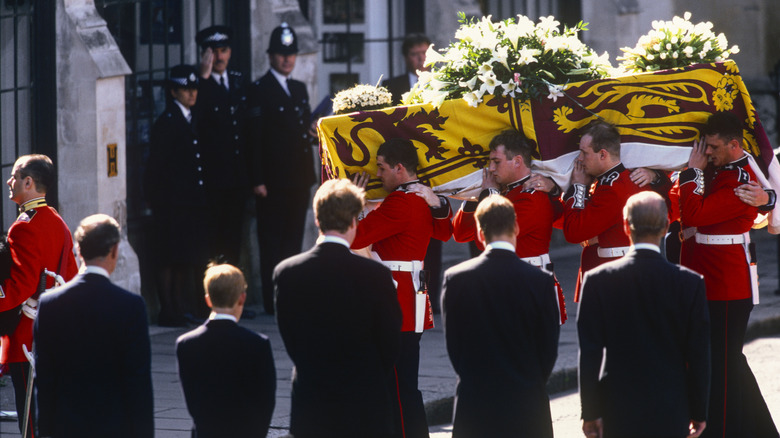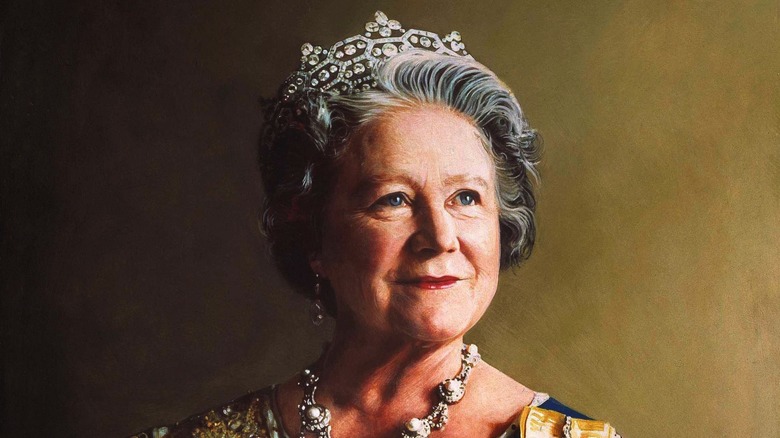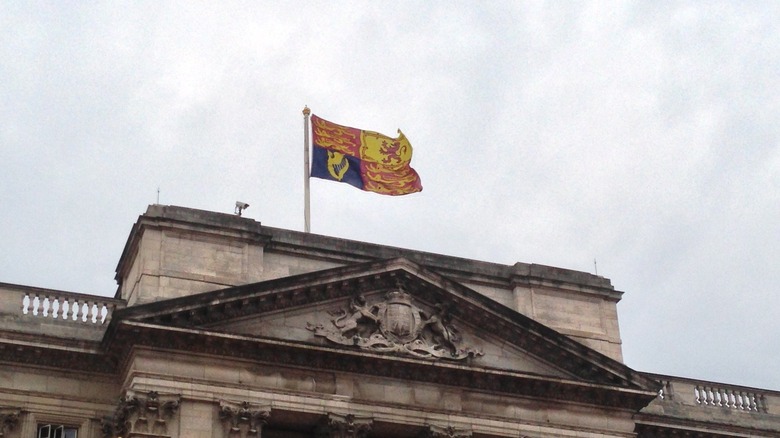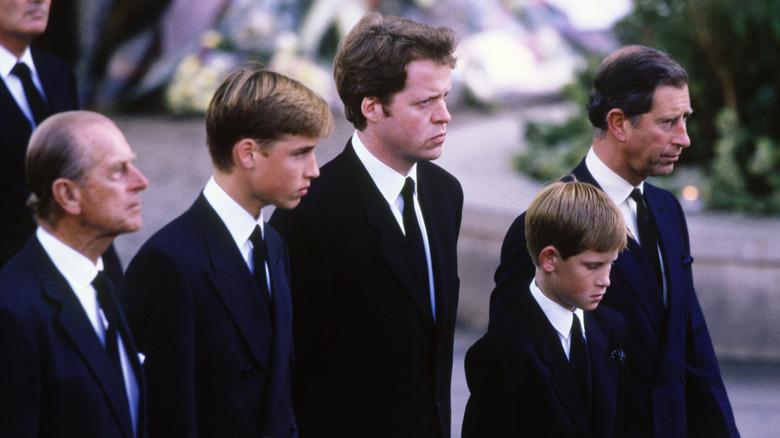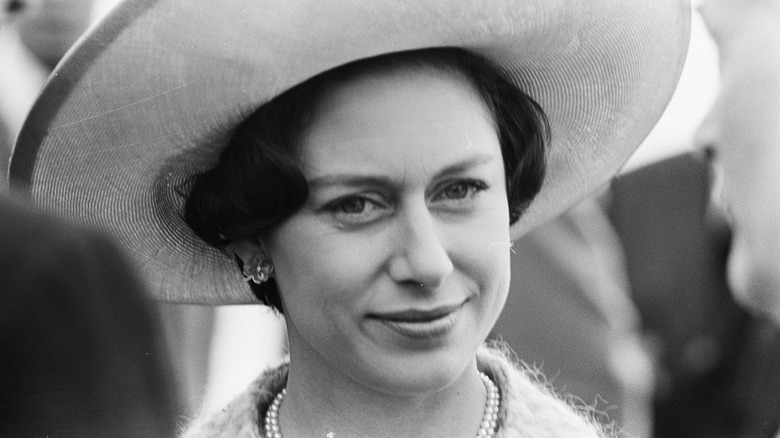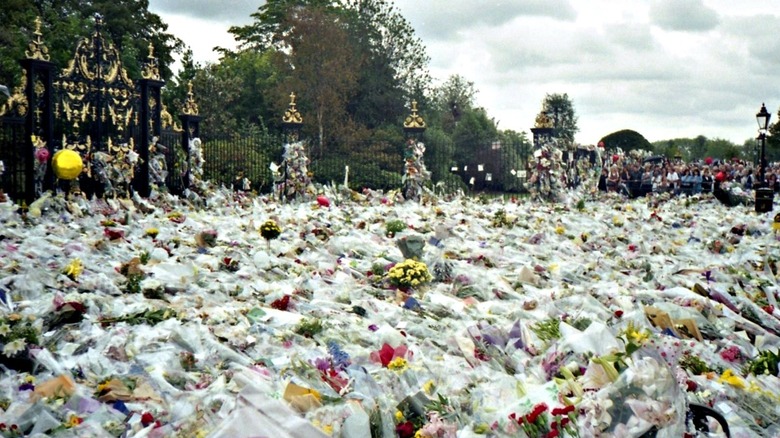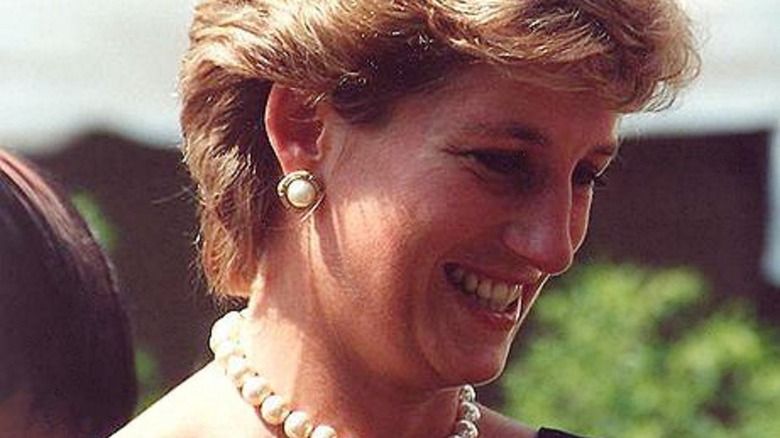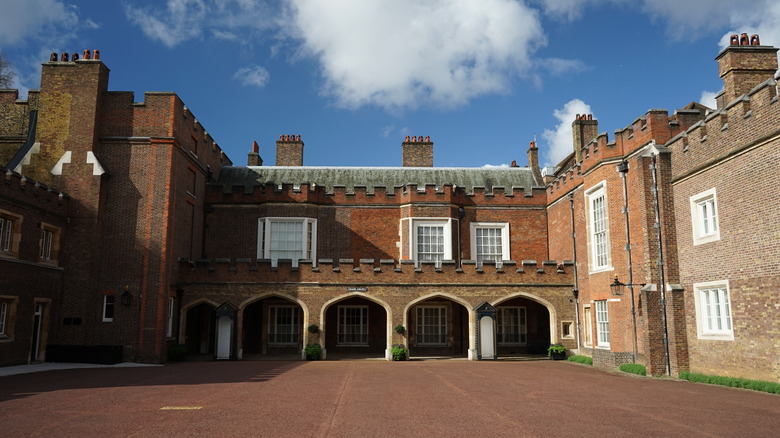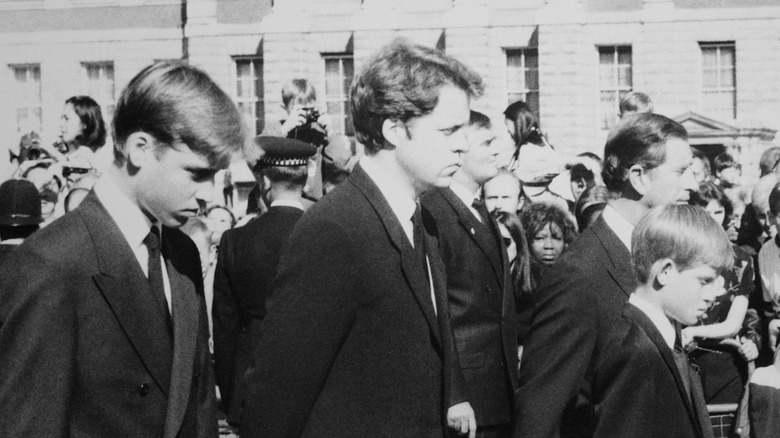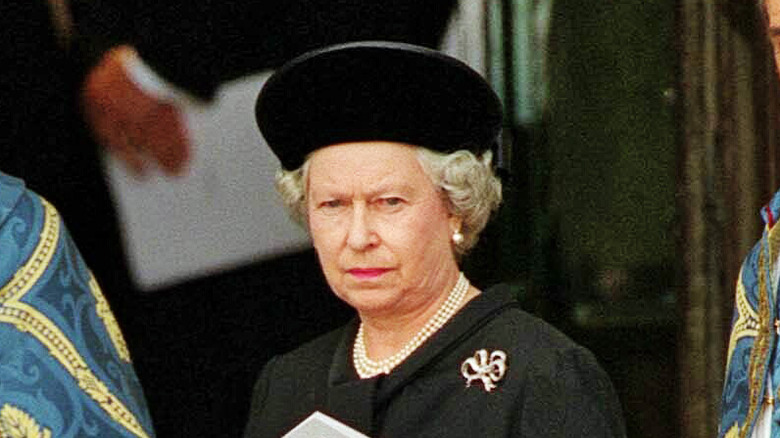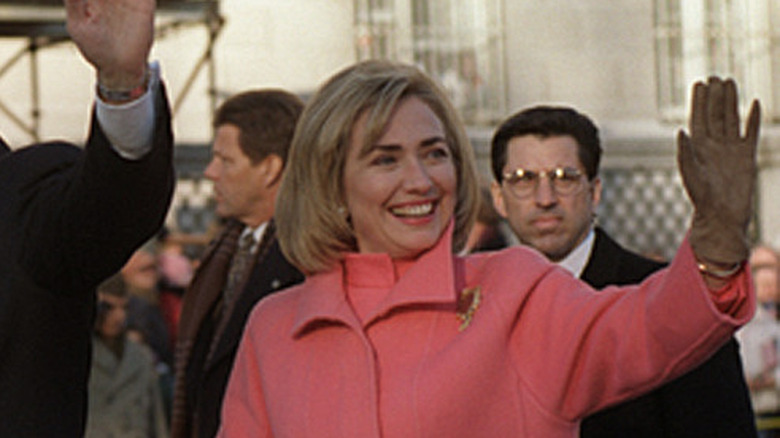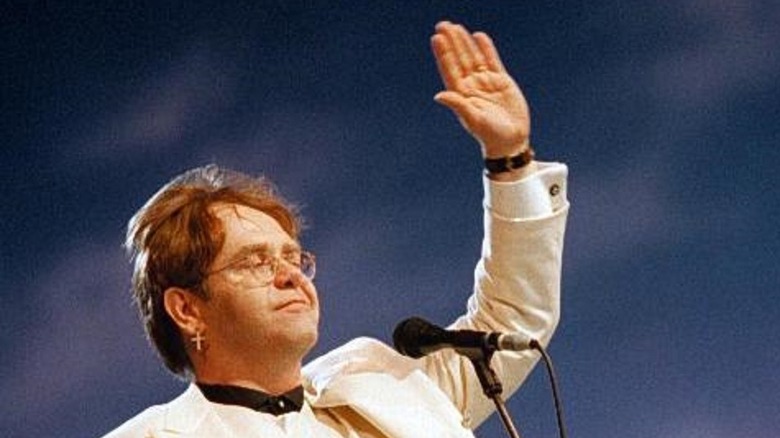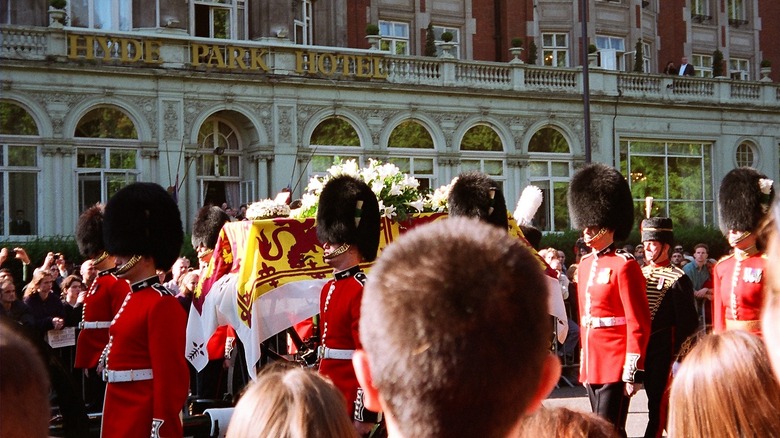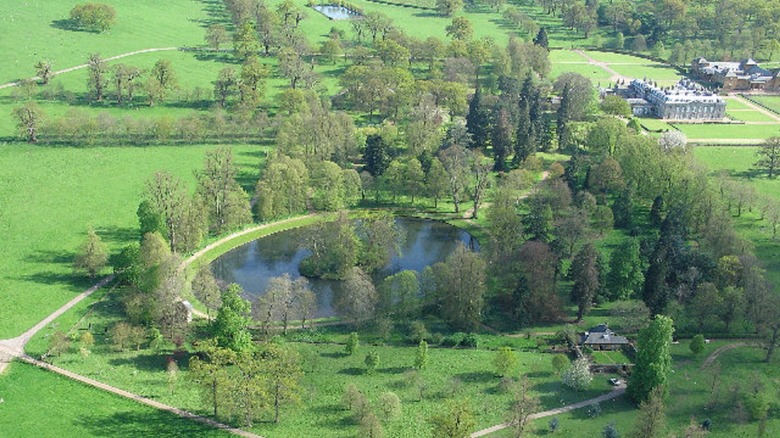The Untold Truth Of Princess Diana's Funeral
On August 31, 1997, the world was stunned when Diana, Princess of Wales, was killed suddenly in a car crash. Diana had weathered a divorce from the heir to the throne and the subsequent gossip about her love life to lay claim to her position as the most popular member of the British royal family in generations. It wasn't just that she was glamorous: It was the warmth she showed to complete strangers, not to mention her sons, Prince William and Prince Harry.
Diana's death cast a glaring spotlight on the remaining royal family. Unfortunately, that included William and Harry, who were watched by billions as they walked behind her coffin. The Queen was also forced to manage the emotions of a public that interpreted her carefully practiced poise as coldness.
Held on September 6, Diana's funeral was a chance to unite the royals, the British public, and the world in a moment of loss. From the guest list to major flag drama and her final interment, here's the untold truth of Princess Diana's funeral.
Princess Diana's funeral was based on plans made for someone else
With only six days between Princess Diana's death and her funeral, there wasn't much time for Palace and government officials to plan the details. The public outpouring of grief raised the stakes further.
Plans have already been made for the funerals and ceremonies of some royals. According to Town and Country, preparations for the Queen's death started in the 1960s, when she was only in her forties. Each person's plan has its own code name. For example, when Prince Philip, Duke of Edinburgh, died on April 9, 2021, Operation Forth Bridge — named for a bridge near Edinburgh — went into action. Elizabeth II's death plan is codenamed London Bridge. The one for her father, George VI, who died in 1952, was named Hyde Park Corner, after a particular spot in a park close to Buckingham Palace.
The plan used when Diana died was nicknamed Tay Bridge, in honor of a bridge in Dundee, Scotland. It's not because she had a particular connection to Scotland. Her death was so sudden that there was no plan in place. Instead, the organizers used one that had been put together for another member of the royal family: Queen Elizabeth the Queen Mother. The Queen Mother was very much alive at the time, although she would die, aged 101, five years later. Which meant she had the unnerving experience of witnessing aspects of her own funeral.
The Queen broke flag-related protocol
In the aftermath of Princess Diana's death, Queen Elizabeth II was accused of coldness towards the famously warm princess. The empty flagpole at Buckingham Palace became a focal point. Until then, the only flag that ever flew over the palace was the flag of the monarch, the Royal Standard. It was only flown when the Queen was present and never at half-mast, since the monarch is either present or not: they can't be half-present. When one monarch dies, the flag immediately transfers to the heir, to show continuity.
When the Queen was away, the Buckingham Palace flagpole was left empty. In the days after Diana's death, she was with her bereaved grandsons at Balmoral Castle in Scotland. However, the public felt that the Palace was snubbing Diana, as the BBC reports. On the day of Diana's funeral, the Queen broke centuries of protocol to honor her ex-daughter-in-law. After the Queen left for the funeral, the Standard was taken down and the Union Flag — the national flag of the United Kingdom — was flown at half-mast.
Since that day, the Union Flag has flown at Buckingham Palace when the Queen is not in residence. The Queen authorized the flying of the Union Flag at half-mast on the first anniversary of Diana's funeral. She went on to repeat the gesture of respect to mark several other periods of national mourning, including the terrorist attacks of September 11, 2001, and 7 July, 2005.
Princess Diana's sons have different views about walking behind her coffin
For many onlookers, the most heart-wrenching image from Princess Diana's funeral was the sight of her two sons, William, 15, and Harry, 12, walking behind their mother's coffin. They were accompanied by their father, Prince Charles; Diana's brother Charles, Earl Spencer; and their paternal grandfather, Prince Philip, the Duke of Edinburgh, who joined as moral support for his grandsons. Earl Spencer later described the walk as the "most horrifying half hour of my life," adding that it must have been so much worse for Prince William and Harry. He said that he was told that the brothers chose to walk with the coffin, and that Diana would not have wanted it.
The brothers disagree somewhat over their role in the procession. In August 2017, William told a BBC documentary that it was one of the most difficult moments of his life. But he added, "There is that balance between duty and family and that's what we had to do."
A few months earlier, Harry had told Newsweek that he didn't think a child should be asked to walk behind their mother's coffin, adding, "I don't think it would happen today." In the documentary, he backtracked, saying that he didn't necessarily think that it was the right or wrong decision, and that he was pleased that he was able to take part in the funeral.
Princess Margaret took her grudge to the funeral
As the funeral procession passed Buckingham Palace, the Queen, Princess Margaret, and other members of the royal family stood outside the gate to pay their respects.
According to a book by Princess Diana's biographer Andrew Morton, excerpted in Town and Country magazine, the Queen bowed her head low as the coffin passed: but her sister Margaret barely nodded. Morton also claimed that right before the procession reached them, while they were waiting by the gates, Margaret was trying to talk to the Queen about improving the bathrooms at Kensington Palace — the nearby home where she and Diana had once lived in adjacent apartments.
The early days of Margaret and Diana's relationship didn't predict this level of coldness. Margaret could relate to Diana's tumultuous experience with the British press: she had once been the royal that most often drew the attention of the paparazzi. But Margaret's loyalty above all was to the Queen and the Crown. When Diana broke the cardinal unwritten rule in the royal handbook with a tell-all interview on the BBC show "Panorama," Margaret immediately turned on her. Even Diana's death wasn't enough to calm the furious princess.
Princess Diana's funeral was a worldwide event
Princess Diana's death was a huge shock to the public, who saw her as the most relatable royal. The New York Times reported that in the days after, members of the public laid as many as 60 million flowers outside Buckingham Palace.
An estimated one million mourners lined the procession route to watch her funeral cortege pass by. So many people were expected that officials had to extend the route to accommodate them. In a 2017 BBC documentary, Prince William recalled that people were, "shouting and literally wailing at us. Throwing flowers, yelling, sobbing, breaking down, people fainted." He said that at the time, he couldn't understand how people who didn't even know Diana could be so affected by her loss, but later learned more about the impact she'd had on the world.
Even people who couldn't attend in person paid their respects. As the LA Times reports, shops and other venues shut down for the duration of the funeral, sports events were postponed or canceled, and the weekly National Lottery Draw was canceled. People across Britain joined in with the minute's silence held at the end of the funeral. An estimated 2.5 billion people watched the live TV broadcast: nearly half the world's population at the time. It also became one of the first internet events, as people connected online to share their stories, collectively mourn, and to petition against the paparazzi.
Princess Diana's funeral was unique
Even in death, Princess Diana forced the royal family to adapt to the modern era. Traditionally, as the BBC reports, there were three types of royal funeral: a state funeral, granted only to the monarch; a ceremonial funeral, for the monarch's consort or heir, or royals who have attained a high military rank; and a private funeral, for everyone else.
When Diana divorced Prince Charles, her royal status dropped in seniority. She was no longer the future queen, but she was still the mother of the second-in-line, and would therefore usually be granted a private funeral. However, her popularity with the public ensured her a much larger send-off. A spokeswoman for the palace told reporters, "This is a unique funeral for a unique person."
Charles may have had a hand in this too. According to CNN, two days after the funeral, a British news show reported that the Queen had wanted Diana to have a small, private funeral, but that Charles and Prime Minister Tony Blair, seeing the public outpouring of grief, had decided that it needed to include the public. The Palace later issued a statement denying rumors of the argument and other supposed incidents that accused the Queen of refusing to pay tribute to Diana, the New York Times reports.
Thousands lined up to sign condolence books
The royal family was left with a physical expression of the publics' grief — several of them, actually — in the form of books of condolence. The books were laid out in St. James' Palace, where Princess Diana's body was also being kept before the funeral, in a private chapel accessible only to her family.
Thousands traveled from across Britain and joined the lines to write their messages of grief, waiting between six-and-a-half to 12 hours, according to the BBC. By September 5, the day before the funeral, there were 43 books of condolence and counting. Others had been placed in British embassies and consulates around the world.
According to an article published in the Sunday Mirror that October, people in other parts of Britain also signed condolence books, which were sent to Kensington Palace, where all the books were eventually moved. Others sent their messages of condolence via the internet. According to the LA Times, the royal family's website received 60,000 virtual messages — not a lot today, but unheard of in 1997.
Princess Diana's brother made a controversial speech
Following the funeral, CNN reported on rumors that the Palace and Princess Diana's family the Spencers had clashed over arrangements. Both parties denied this, with Charles, Earl Spencer, describing the claims as "laughable." However, he did manage to ruffle a few royal feathers with his eulogy.
He started by praising Diana's compassion and selflessness, while also acknowledging, "You stand tall enough as a human being of unique qualities not to need to be seen as a saint." Towards the end, Charles criticized the media, whose relentless pursuit of Diana he believed had caused her death. He described his sister as, "the most hunted person of the modern age." In the final section of his speech, Charles promised Diana that "your blood family" would do everything they could to honor her plans for raising her sons. He went on, "[We] will always respect and encourage them in their royal role but we, like you [Diana], recognize the need for them to experience as many different aspects of life."
The public listening outside the Abbey erupted in applause. The speech has been described as one of the greatest in British history. It was also seen as an accusation that the Palace had tried to metaphorically cage Diana's vibrant spirit. Charles later claimed that was not his intention, and said that he'd heard that the Queen, asked about the speech, had replied, "He had every right to say whatever he felt."
Some royals paid tribute to Princess Diana through their outfits
Both Princess Diana's ex-husband and ex-mother-in-law used their outfits to pay silent tribute to her at her funeral. Prince Charles broke with the British royal family's tradition of wearing black mourning clothes by choosing a navy blue suit for Diana's funeral. To the casual observer, this may have seemed disrespectful. Charles and Diana had been through a three-year separation culminating in a bitter divorce, finalized a year before her death. Navy blue may have looked flippant. However, Charles' decision to skirt tradition was actually intended as a nod to his style icon ex-wife. As CBS News reports, the suit Charles wore to the funeral had been Diana's favorite.
Meanwhile, his mother Queen Elizabeth II used her jewelry to honor Diana. Since she's supposed to be politically neutral, the Queen is known for subtly broadcasting her thoughts through her wardrobe, particularly her brooches. For Diana's funeral, she wore one of the Victoria bow brooches: three brooches shaped like bows and studded with diamonds, commissioned by Queen Victoria. Shortly before her death, Victoria designated the brooches as heirlooms of the crown, which are passed down from queen to queen or queen consort. Elizabeth also wore one of the bow brooches on the day she surpassed Victoria's reign. Perhaps they represent a long line of British queens, including the Princess of Wales who never made it to the throne.
Princess Diana's funeral was attended by A-list guests
Approximately 2,000 people were invited to the funeral service inside Westminster Abbey. In addition to members of the royal family, the guest list for Princess Diana's funeral included global dignitaries, and some notable names you might not expect.
Although Diana didn't officially receive a state funeral, various countries still sent unofficial representatives. Then-First Lady Hillary Clinton (pictured above on her husband's second Inauguration Day in 1997) represented America, as did former U.S. Secretary of State Henry Kissinger. The French President's wife, Bernadette Chirac, attended on behalf of the country in which Diana had been killed. Then-Prime Minister Tony Blair — the man who coined Diana's nickname "the people's princess" after her death — and his wife Cherie attended: The PM gave a reading during the service. Four former prime ministers also went.
So far so predictable. But Diana was also popular outside stuffy state business. As USA Today reports, her funeral was also attended by movie royalty, including Tom Cruise and Nicole Kidman (a couple at the time), Tom Hanks, Steven Spielberg, and Sir Richard Attenborough (best known as John Hammond in "Jurassic Park.") British entertainers George Michael and Cliff Richard were also there, as did opera singer Luciano Pavarotti.
Elton John performed
Of all the musicians who attended Princess Diana's funeral, her friend Elton John was chosen to perform. Diana and John became fast friends after meeting at Prince Andrew's 21st birthday party. John said he and Diana enjoyed gossiping together, and they also shared a mutual interest in promoting AIDS charities. However, that led to a major falling out, when Diana unexpectedly pulled out of a photobook that would have raised money for the AIDS Foundation, sending John a cold note with no satisfactory explanation.
It took another funeral for the two to make up, for their mutual friend Gianni Versace. Diana died five weeks later.
At Diana's funeral, John performed an updated version of his 1973 song "Candle in the Wind." He called up frequent Beatles' producer George Martin, who arranged a string quartet version. The original was about Marilyn Monroe, so John's songwriting partner Bernie Taupin changed the lyrics to honor Diana. "Goodbye Norma Jean" became "Goodbye England's rose," for example. John was so nervous about getting the words wrong that he used a teleprompter, according to Reuters. It was the only time he performed that version of the song live, but when it was released on September 13, it became the best-selling song not only of 1997 but of all time in the U.K. Worldwide, it's only been outsold by Bing Crosby's "White Christmas." The proceeds of the single were donated to Diana's favorite charities.
Princess Diana's coffin was lined with lead
Some aspects of Princess Diana's coffin were very in keeping with British royal tradition. For example, during the funeral procession, the coffin was draped with the Royal Standard, trimmed with an ermine border. This flag is flown above palaces — and the Houses of Parliament — when the Queen is in residence, and is also used for royals who don't have their own flags, according to the Chicago Tribune. The senior members of the royal family all have their own variations on the Standard, to indicate rank and titles.
Another traditional feature was that the coffin was lined in lead. This is common among members of the royal family, as lead helps preserve the body better. Spare a thought for the pallbearers: Not only were they managing extra weight, but they probably would have had to leave the country if they'd dropped the coffin.
However, Diana's coffin didn't look completely identical to those of British royals throughout history. Before she was transported through the streets of London to Westminster Abbey, her sons William and Harry had placed a white floral arrangement on top, with a handwritten envelope that simply and heartbreakingly read "Mummy."
Princess Diana wasn't buried in Westminster Abbey
Westminster Abbey is the final resting place of many notable British royals, including Henry VII, Elizabeth I, and (awkwardly) Mary, Queen of Scots. But Diana is not among them. According to the BBC, her brother Charles, Earl Spencer, originally planned to have her interred at their family's vault in the local church near their childhood home of Althorp. However, he ultimately decided to bury Diana on the estate's private grounds, where she wouldn't be disturbed by well-wishers. (Despite this, in 2017, he said that there had been four attempts to break into her tomb.) After the funeral, Diana's coffin was driven the 70 miles from London to the estate, where she was interred in a private ceremony attended by only close family, and conducted by a priest who was a family friend.
The spot Charles chose is on an island on a lake called the Oval, overlooked by trees planted by members of Diana's family, including her sons, and by the princess. It is marked with a statue, and a small temple on the shore.
Although members of the public visiting the estate on open days aren't allowed onto the island, Diana has some company. Several family pets are buried there, according to the Chicago Tribune, including her cat Marmalade. Some criticized Charles for this: but given that his main aim was to give William and Harry a place to privately mourn their mother, they certainly have a beautiful spot.
